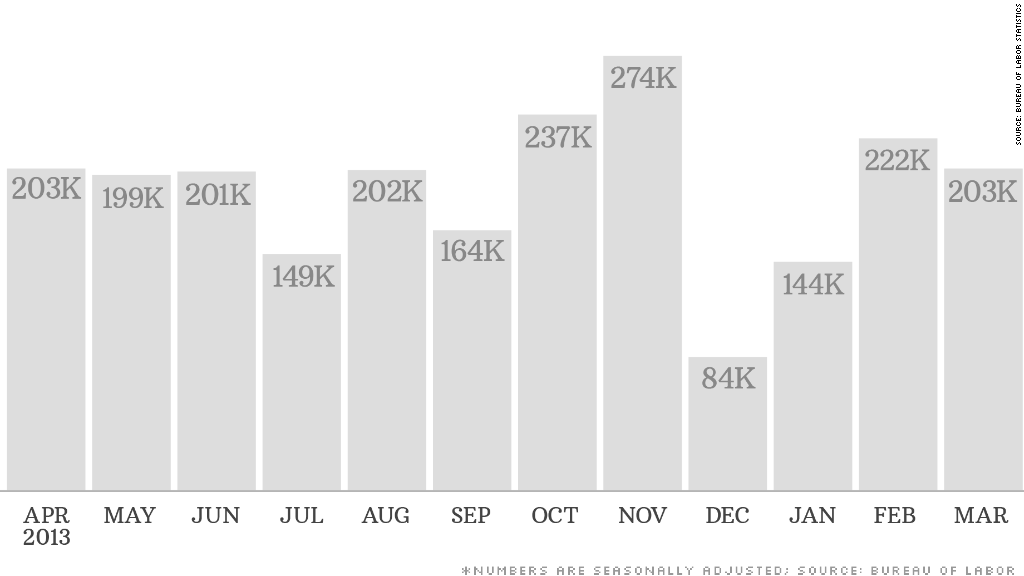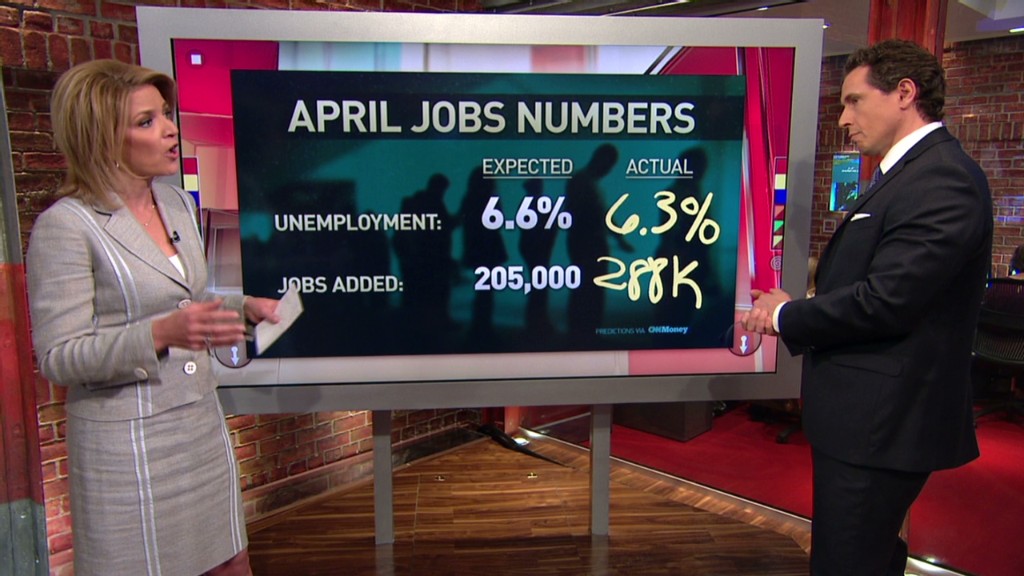
The jobs recovery is chugging along, but the labor market remains far from fully healed from the crisis.
The U.S. economy added 288,000 jobs in April, the strongest month for job growth in two years, the Department of Labor said Friday. That number blew away economists' forecasts, and stocks rose following the news, although they have since fallen back.
The oft-quoted unemployment rate fell to 6.3%, down from 6.7% in March.
The severe winter had been holding back many economic statistics, as snowstorms slowed the housing market, retail sales and manufacturing. On Friday, the jobs numbers were revised higher for both February and March, showing the economy is over that winter lull.
"I'm very happy. It's good to see the economy kicking into gear and that we've really gotten past the weather issue," said John Silvia, chief economist for Wells Fargo.
Related: U.S. economy slows to stall-speed
That said, the unemployment rate told a more discouraging story. That number, which comes from a survey of households, shows fewer Americans are joining the labor force and fewer people report they're employed. These trends led to the unemployment rate falling to 6.3%, its lowest level since September 2008.
"The drop in participation is not due to discouraged workers leaving the labor force," a Department of Labor spokesperson noted, "it's due to re-entrants and new entrants who we expected to see flowing into the labor force, and who didn't this month."
This could mean fewer young people are entering the job market for the first time, and more seniors are retiring and staying that way. That said, participation also fell among the prime working-age population, and that's a discouraging sign, said Diane Swonk, chief economist for Mesirow Financial.
"These are our 'learners and earners' in society," she wrote in a blog post. "They should be in the prime of their careers; instead, they are un- or underemployed, struggling with a debilitating overhang of student debt and in a sad reflection of our economy, some are giving up entirely."
Related: Class of 2014 faces tough job market
Economists also caution not to read too much into just one month of data. The big picture remains the same.
"The employment data can fluctuate from month to month, and while this month's report happens to be above expectations, it is still broadly consistent with the recent trends we have been seeing in the labor market," Jason Furman, top economic adviser to President Obama, wrote in a White House blog post. (Political reaction)
Given the millions of jobs lost in the financial crisis, even solid hiring is still not enough to put the huge backlog of unemployed Americans back to work right away. The jobs recovery has dragged on for four years now, and long-term unemployment remains elevated with 3.5 million people out of a job for six months or more.
Related: Recovery on track, but still slow and steady
Economists estimate it could take at least another two years until the job market returns to its pre-recession health, when the unemployment rate was around 4% to 5%.

The good news is, the recovery is now broad-based across many industries.
One of the strongest sectors for job growth, for example, is professional and business services. The industry added 75,000 jobs in April. Over the last 12 months, it has added more than 660,000 jobs. Many of these are likely to be office jobs paying mid- to high-level wages.
Retail, restaurants and bars -- traditionally low-wage industries -- have also accounted for strong job growth, and blue-collar industries like manufacturing and construction are on the upswing.
The only major sector that continues to cut jobs is the federal government, which slashed 83,000 positions over the last 12 months.


